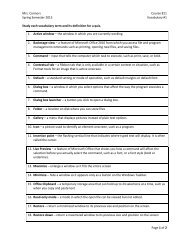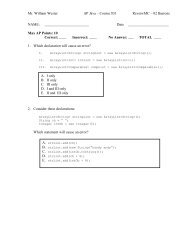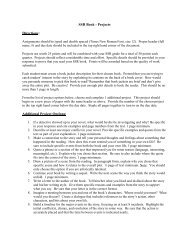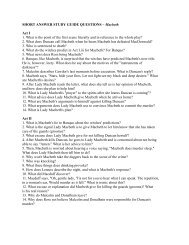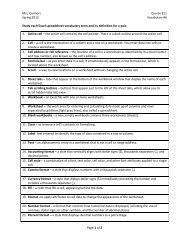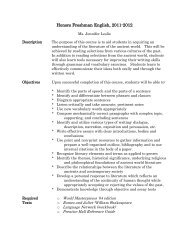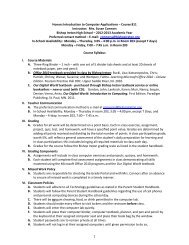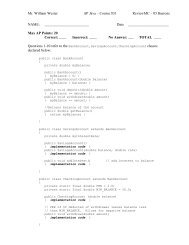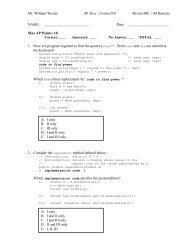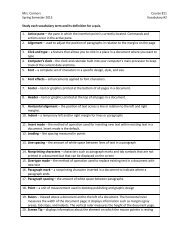Stability Across Cohorts in Divorce Risk Factors - Bishop Ireton High ...
Stability Across Cohorts in Divorce Risk Factors - Bishop Ireton High ...
Stability Across Cohorts in Divorce Risk Factors - Bishop Ireton High ...
You also want an ePaper? Increase the reach of your titles
YUMPU automatically turns print PDFs into web optimized ePapers that Google loves.
342 Demography, Volume 39-Number 2, May 2002<br />
The effect of the husband be<strong>in</strong>g older on divorce is positive <strong>in</strong> both the bivariate and<br />
additive effect models. The effect of the wife be<strong>in</strong>g older is substantial. In the <strong>in</strong>teraction<br />
effect model, if a wife is five or more years older than her husband, the risk of divorce is<br />
88% higher <strong>in</strong> comparison with a marriage that has relative age homogamy. The effect of<br />
the wife hav<strong>in</strong>g more education is also positive, although not significant us<strong>in</strong>g the BIC<br />
criterion for strong evidence, <strong>in</strong>creas<strong>in</strong>g the risk of divorce by 9% at each marital duration.<br />
The effect of the wife’s education is <strong>in</strong>terest<strong>in</strong>g <strong>in</strong> that it reverses direction between<br />
the bivariate model and the two multivariate models. In the bivariate model, the risk of<br />
marital disruption decreases 6% for each additional year of school<strong>in</strong>g the wife has. In the<br />
multivariate models, the risk of divorce <strong>in</strong>creases 4%–5% for each additional year of the<br />
wife’s school<strong>in</strong>g. The switch from a negative to a positive effect is due mostly to the<br />
<strong>in</strong>clusion of the control for husband’s education (results not shown). More-educated<br />
women are generally married to more-educated men, and the effect of the husband’s education<br />
is substantial and negative.<br />
The effect of be<strong>in</strong>g Catholic is to reduce the risk of marital dissolution, and the effect<br />
of the wife’s parents hav<strong>in</strong>g divorced is positive. In both cases, though, the effect is reduced<br />
somewhat with the <strong>in</strong>troduction of the other covariates. In the <strong>in</strong>teraction model, at<br />
each marital duration, Catholics are 11% less likely to divorce, and couples <strong>in</strong> which the<br />
wives’ parents divorced are 38% more likely to divorce.<br />
There is no difference between whites and respondents report<strong>in</strong>g neither white nor<br />
black race <strong>in</strong> the risk of marital dissolution. Blacks are substantially more likely to divorce<br />
at each marital duration than are whites. However, this effect changes across time.<br />
In the 1950–1954 cohort, the risk of divorce for blacks is 83% greater (1.97 × .93 = 1.83).<br />
In the 1980–1984 cohort, the risk of marital dissolution for blacks is only 19% higher.<br />
This pattern results from the fact that the risk of marital dissolution <strong>in</strong>creases more slowly<br />
(by a factor of .93) for blacks than for whites.<br />
A Test for Proportionality<br />
All the models estimated up to this po<strong>in</strong>t assume that the effects of the covariates are<br />
proportional. That is, the effects of the predictor variables are assumed to be equal at all<br />
marital durations. A test for proportionality is key for the purposes of this study to account<br />
for the possibility that historical shifts <strong>in</strong> the risk of divorce may be confused with<br />
nonproportionality. In particular, a variable with an effect that <strong>in</strong>creases (decreases) with<br />
marital duration may be mistaken for a variable with an <strong>in</strong>creas<strong>in</strong>g (decreas<strong>in</strong>g) effect<br />
across historical time.<br />
In general, two rationales have been put forward to suspect nonproportionality. First,<br />
as marriages mature, <strong>in</strong>dividuals accrue more marital-specific capital (Becker et al.<br />
1977), decreas<strong>in</strong>g the risk of divorce. Thus, <strong>in</strong>dividual couples change with respect to<br />
their risk of marital disruption. Second, as marriages progress, a process of sort<strong>in</strong>g occurs,<br />
weed<strong>in</strong>g out couples who are less suited to each other or less committed to a permanent<br />
relationship (Morgan and R<strong>in</strong>dfuss 1985; South and Spitze 1986; Teachman<br />
1986). The rema<strong>in</strong><strong>in</strong>g marriages are therefore composed of couples who are less likely to<br />
divorce.<br />
The empirical evidence is limited, but a number of researchers, us<strong>in</strong>g different data<br />
and methods, have found that the effect of age at marriage is stable across marital duration<br />
(Morgan and R<strong>in</strong>dfuss 1985; South and Spitze 1986; Teachman 1986; Thornton and<br />
Rodgers 1987). Morgan and R<strong>in</strong>dfuss (1985) reported that the positive effect on divorce<br />
of hav<strong>in</strong>g a premarital birth decl<strong>in</strong>es at longer marital durations, but Teachman (1986)<br />
found a more consistent effect for this variable. South and Spitze (1986) and South (2001)<br />
<strong>in</strong>dicated that the effect of the wife’s education changes from be<strong>in</strong>g negative to be<strong>in</strong>g<br />
positive as marriages mature. Aga<strong>in</strong>, however, Teachman (1986) found a consistent effect<br />
of the wife’s education across different marital durations.




